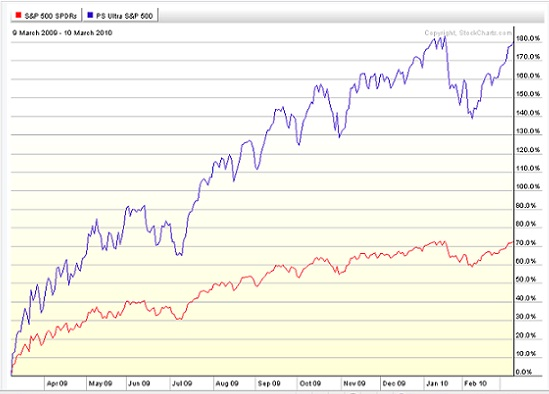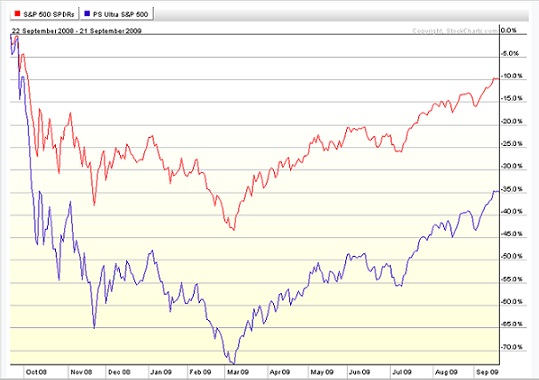The past year’s market has been a tough one for long-term investors. We
saw the S&P 500 locked in a trading range from mid-November through
mid-July with 1,250 serving as the low and 1,350 as the top.
This range subsequently gave way as the index dropped sharply during a
three week period from July 22 through August 9, only to get stuck in
another trading range. This one lasted from August 9 to October 21, with
1,100 serving as the low and 1,225 as the top.
What should long-term investors do during a period like this where
trading ranges, not an extended trend, dominates? I suggest using inverse
and leveraged ETFs.
Because of the choppiness of the market over the last year, the best way
to benefit has been to play the swings. Now, you could use options in a
time like this, but if you are not a fan of options, leveraged ETFs offer
similar returns only without the time decay presented by options.
Before I get into how I use leveraged and inverse funds, an explanation
of how these funds operate is in order.
Inverse funds are designed to move up when the underlying index moves
down. These are bearish investment tools.
For instance, the S&P500 SPDR (NYSE: SPY) tracks the
movement of the S&P 500 and it allows investors to experience the
same returns as the index. The ProShares Short S&P500 Fund
(NYSE: SH) is the inverse fund. If the S&P goes down one
percent, the SH will go up approximately one percent.
Look at the chart below which tracks the SPY and the SH exchange traded
funds over the last six months. The SH is the mirror image of the SPY. An
investor that bought the SH would have done very well from April 29
through August 8. During this time, the SH gained almost 20 percent while
the S&P lost 17.3 percent.

So how do I personally use inverse ETFs?
If I think we are due for a long-term correction based on the three
analysis styles I follow – technical, fundamental, and sentiment – I will
look to purchase an inverse ETF like the SH. In the ETF Master
Portfolio I look to hold funds for a minimum of six months. If I
am looking for a prolonged correction or bear market, I will recommend an
inverse fund for the portfolio.
Buying an inverse ETF offers investors a chance to profit from a downturn
in the market. They also offer an advantage over short selling as there
aren’t any margin requirements or interest charges.
Over the last 10 years, the buy and hold philosophy has yielded next to
nothing. In order to have made money in the market, you either had to
move in and out or you had to be willing to make money on the bearish
side. Inverse ETFs offer investors an easy way to profit from a
downturn.
Another type of ETF investors can use are leveraged ETFs. Leveraged funds
use derivatives to double or triple the movements of the underlying
stocks. For example, the ProShares Ultra S&P500 (NYSE:
SSO) is a double leveraged fund that is designed to move twice
as much as the SPY.
Notice how I worded that last sentence, “designed to move”. Because these
funds use options and other leveraged instruments the relationship
doesn’t always maintain that perfect two-to-one ratio. In fact, my
experience tells me that the longer the leveraged ETF is held, the less
likely the coorelation is to be maintained and the more leverage applied,
the more apt the relationship is to diverge.
Take a look at the chart of the SPY versus the SSO from March 2009
through March 2010. You’ll see that the SSO was up 181 percent while the
SPY was up 72.7 percent. In this instance, the relationship broke down
since the SSO was up way more than twice as much as the SPY. In this case
it was to the SSO investors advantage. But trust me, that isn’t always
the case.

If you look at this second chart from September 2008 through September
2009, the SPY only lost 9.74 percent while the SSO lost 34.62 percent.
Clearly, the leverage instrument used and the duration of the holding
impacts the two to one correlation.

Timing can be everything when you use leveraged ETFs. And you also have
to remember that the leverage works in both directions. If you are wrong,
you stand to lose twice as much – or three times, depending on which
particlular levered ETF you buy. These investments are similar to options
in that when you are right you stand to make a lot of money, and when you
are wrong you can lose a lot.
With this in mind, I prefer to use the regular inverse funds when I have
a long-term bearish outlook. If I am right and the market moves
significantly lower, my return will be sufficient and I am making money
when the market is falling.
If I have a short-term bearish outlook, I am more apt to use the
leveraged inverse ETFs. In this scenario I am looking for a quick
correction where I have definitive stop-loss points and definitive exit
points to take gains.
Put it this way; I consider the inverse funds and the straight ETFs as
investment tools.
The two and three times leveraged ETFs are trading tools.
The difference between investing and trading for me is the target time
frame. Investors are in it for months or years whereas traders are in for
hours or days.
But regardless of your strategy and your timeframe, there is an ETF that
will suit your style and help boost your returns during a volatile
market.
Rick Pendergraft
Editor
ETF Master Portfolio
 Facebook
Facebook
 Twitter
Twitter